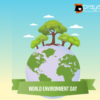13th October: International Day for Disaster Risk Reduction
The International Day for Disaster Risk Reduction was started in 1989, after a call by the United Nations General Assembly for a day to promote a global culture of risk-awareness and disaster reduction. Held every 13 October, the day celebrates how people and communities around the world are reducing their exposure to disasters and raising awareness about the importance of reining in the risks that they face.
In 2015 at the Third UN World Conference on Disaster Risk Reduction in Sendai, Japan, the international community was reminded that disasters hit hardest at the local level with the potential to cause loss of life and great social and economic upheaval. Sudden onset disasters displace millions of people every year. Disasters, many of which are exacerbated by climate change, have a negative impact on investment in sustainable development and the desired outcomes.
This year’s International Day for Disaster Risk Reduction is all about governance. You can measure good disaster risk governance in lives saved, reduced numbers of disaster-affected people and reduced economic losses. COVID-19 and the climate emergency are telling us that we need clear vision, plans and competent, empowered institutions acting on scientific evidence for the public good.
Natural disasters are catastrophic events that destroy property and cause loss of life. These types of disasters also result in economic upheaval. Because of natural disasters, millions of people are displaced each year. Any natural event that kills over ten people or injures at least 100 is considered a natural disaster. These disasters kill about 90,000 people and affect 160 million people each year. Between 1964 and 1983, natural disasters killed nearly 2.5 million people throughout the world. During this timeframe, another 750 million were injured or displaced.














 We can help you.
We can help you. 




